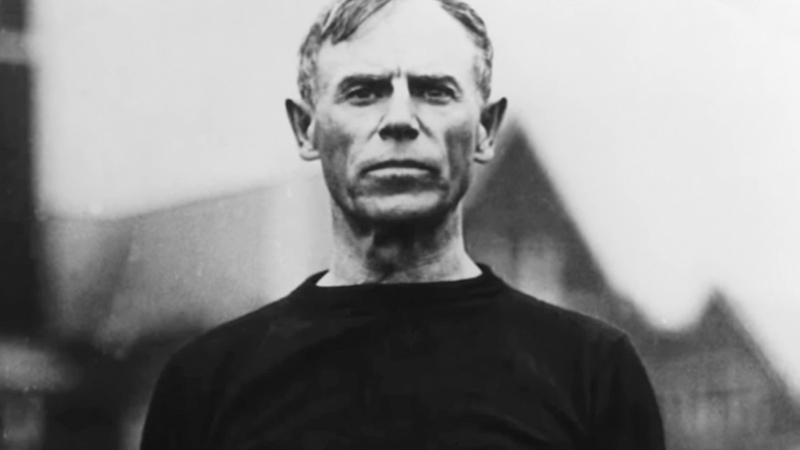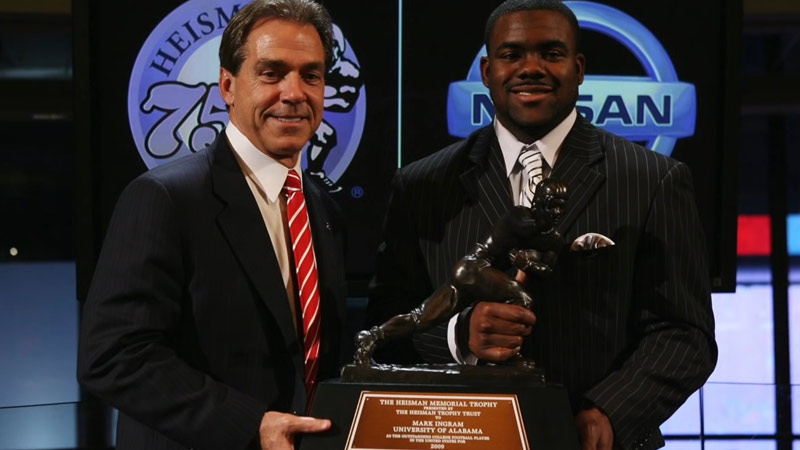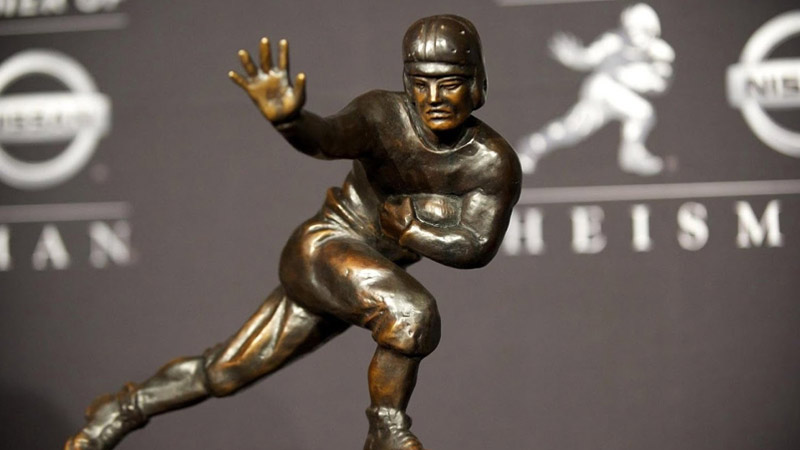In the realm of American college football, one accolade stands above the rest, symbolizing the pinnacle of individual achievement and athletic prowess.
The Heisman Trophy, an iconic symbol of excellence, has been awarded annually since 1935 to the most outstanding player in college football.
Named after the renowned coach and athletic director John W. Heisman, this prestigious award has become synonymous with greatness and serves as a testament to the dedication, skill, and determination of its recipients.
The Heisman Trophy is not merely a symbol of athletic dominance, but a reflection of the values and spirit of the game. It represents the culmination of a player’s exceptional performance, leadership, and impact on their team’s success.
Join us as we delve into the Heisman Trophy, exploring its origins, the selection process, and the remarkable individuals who have etched their names into college football immortality.
What Is the Heisman Trophy?
The Heisman Trophy is an annual award presented to the most outstanding college football player in the United States. It is named after John W. Heisman, a former player and coach, and has been awarded since 1935.
The Heisman Trophy is considered one of the most prestigious individual awards in college football and is often seen as a symbol of excellence and achievement in the sport.
The winner is selected by a panel of sports journalists and former players, who vote based on the player’s performance, statistics, leadership, and overall impact on the game. The recipient of the Heisman Trophy is typically announced in early December, and the award ceremony takes place shortly thereafter.
History of the Heisman Trophy

The Heisman Trophy has a rich history that dates back to 1935. It was established by the Downtown Athletic Club (DAC) in New York City and named after John W. Heisman, a prominent football player and coach who had a significant impact on the sport.
The first Heisman Trophy was awarded to Jay Berwanger, a running back from the University of Chicago. Since then, the award has been presented annually to the most outstanding college football player in the United States.
Over the years, the Heisman Trophy has become one of the most prestigious individual awards in college football. It recognizes exceptional skill, leadership, and performance on the field. The recipient is chosen through a voting process conducted by a panel of sports journalists and former players.
The trophy itself features a bronze statue of a football player in a classic stiff-arm pose, designed by sculptor Frank Eliscu. It has become an iconic symbol of achievement in college football.
The Heisman Trophy ceremony is typically held in early December, and the winner is announced during a nationally televised event. The recipient receives the trophy and delivers an acceptance speech, often expressing gratitude to their teammates, coaches, and supporters.
What Does the Heisman Trophy Represent?

The Heisman Trophy represents excellence, achievement, and recognition in college football. It symbolizes the hard work and talent of the individual player, the success of their team, and the collective efforts of their supporters.
It carries historical and cultural significance and is a highly coveted honor in the sport. Here’s a breakdown of what the Heisman Trophy represents, divided into subheadings:
Excellence and Achievement
The Heisman Trophy represents excellence and achievement in college football. It is awarded to the most outstanding player in the sport, recognizing their exceptional skill, leadership, and impact on the game.
Winning the Heisman Trophy signifies a player’s exceptional performance and sets them apart as one of the best in college football during that particular season.
Symbol of Success
The trophy itself, featuring a bronze statue of a football player in a stiff-arm pose, has become an iconic symbol of success in college football. It represents the hard work, dedication, and talent required to excel at the highest level of the sport.
The Heisman Trophy is a testament to a player’s skills, contributions to their team’s success, and their impact on the game.
Historical and Cultural Significance
The Heisman Trophy has been awarded since 1935 and carries historical and cultural significance in college football.
It is deeply ingrained in the fabric of the sport and has become one of its most prestigious individual awards.
The list of past winners includes legendary players whose names are forever associated with excellence and achievement in college football.
Recognition of Collective Efforts
The Heisman Trophy recognizes not only the individual player but also the collective efforts of their teammates, coaches, and supporters.
It acknowledges the contributions of those who have helped the winner reach their full potential and achieve greatness on the football field. The trophy represents the teamwork and support system that contribute to a player’s success.
How Is the Voting Done?

The voting process for the Heisman Trophy involves a panel of sports journalists and former players who participate in the selection process. Here’s an overview of how the voting is typically done:
Selection Committee
The Heisman Trophy selection committee consists of approximately 870 members, including sports journalists, broadcasters, and former Heisman winners.
The committee is divided into six regions across the United States, with each region having approximately 145 members.
Nomination Process
At the end of the college football regular season, the Heisman Trophy Trust sends out ballots to the selection committee members.
The ballots contain a list of players who are considered potential candidates for the Heisman Trophy. The committee members are asked to vote for their top three choices, ranking them in order of preference.
Point System
The Heisman Trophy voting follows a point system, where each committee member assigns points to their top three choices. The first-place vote receives three points, the second-place vote receives two points, and the third-place vote receives one point.
Tabulation and Finalists
After the voting period ends, the Heisman Trophy Trust collects and tabulates the votes. The players who receive the highest number of points become the finalists for the Heisman Trophy. Typically, three to five players are invited to the Heisman Trophy ceremony as finalists.
Final Voting and Winner Announcement
The final voting takes place during the Heisman Trophy ceremony, which is usually held in early December. The finalists’ vote totals are reset to zero, and the committee members cast their votes again, selecting their top choice from the finalists.
The player who receives the highest number of votes in the final round is announced as the winner of the Heisman Trophy.
It’s important to note that the exact details of the voting process may vary slightly from year to year, but the general principles outlined above are typically followed.
List of the Heisman Trophy Winners
Here is a list of the Heisman Trophy winners from 1935 to 2021:
1935 – Jay Berwanger (University of Chicago)
1936 – Larry Kelley (Yale University)
1937 – Clint Frank (Yale University)
1938 – Davey O’Brien (Texas Christian University)
1939 – Nile Kinnick (University of Iowa)
1940 – Tom Harmon (University of Michigan)
1941 – Bruce Smith (University of Minnesota)
1942 – Frank Sinkwich (University of Georgia)
1943 – Angelo Bertelli (University of Notre Dame)
1944 – Les Horvath (Ohio State University)
1945 – Doc Blanchard (United States Military Academy)
1946 – Glenn Davis (United States Military Academy)
1947 – John Lujack (University of Notre Dame)
1948 – Doak Walker (Southern Methodist University)
1949 – Leon Hart (University of Notre Dame)
1950 – Vic Janowicz (Ohio State University)
1951 – Dick Kazmaier (Princeton University)
1952 – Billy Vessels (University of Oklahoma)
1953 – John Lattner (University of Notre Dame)
1954 – Alan Ameche (University of Wisconsin)
1955 – Howard Cassady (Ohio State University)
1956 – Paul Hornung (University of Notre Dame)
1957 – John David Crow (Texas A&M University)
1958 – Pete Dawkins (United States Military Academy)
1959 – Billy Cannon (Louisiana State University)
1960 – Joe Bellino (United States Naval Academy)
1961 – Ernie Davis (Syracuse University)
1962 – Terry Baker (Oregon State University)
1963 – Roger Staubach (United States Naval Academy)
1964 – John Huarte (University of Notre Dame)
1965 – Mike Garrett (University of Southern California)
1966 – Steve Spurrier (University of Florida)
1967 – Gary Beban (University of California, Los Angeles)
1968 – O.J. Simpson (University of Southern California)
1969 – Steve Owens (University of Oklahoma)
1970 – Jim Plunkett (Stanford University)
1971 – Pat Sullivan (Auburn University)
1972 – Johnny Rodgers (University of Nebraska)
1973 – John Cappelletti (Pennsylvania State University)
1974 – Archie Griffin (Ohio State University)
1975 – Archie Griffin (Ohio State University)
1976 – Tony Dorsett (University of Pittsburgh)
1977 – Earl Campbell (University of Texas)
1978 – Billy Sims (University of Oklahoma)
1979 – Charles White (University of Southern California)
1980 – George Rogers (University of South Carolina)
1981 – Marcus Allen (University of Southern California)
1982 – Herschel Walker (University of Georgia)
1983 – Mike Rozier (University of Nebraska)
1984 – Doug Flutie (Boston College)
1985 – Bo Jackson (Auburn University)
1986 – Vinny Testaverde (University of Miami)
1987 – Tim Brown (University of Notre Dame)
1988 – Barry Sanders (Oklahoma State University)
1989 – Andre Ware (University of Houston)
1990 – Ty Detmer (Brigham Young University)
1991 – Desmond Howard (University of Michigan)
1992 – Gino Torretta (University of Miami)
1993 – Charlie Ward (Florida State University)
1994 – Rashaan Salaam (University of Colorado)
1995 – Eddie George (Ohio State University)
1996 – Danny Wuerffel (University of Florida)
1997 – Charles Woodson (University of Michigan)
1998 – Ricky Williams (University of Texas)
1999 – Ron Dayne (University of Wisconsin)
2000 – Chris Weinke (Florida State University)
2001 – Eric Crouch (University of Nebraska)
2002 – Carson Palmer (University of Southern California)
2003 – Jason White (University of Oklahoma)
2004 – Matt Leinart (University of Southern California)
2005 – Reggie Bush (University of Southern California) [Vacated]
2006 – Troy Smith (Ohio State University)
2007 – Tim Tebow (University of Florida)
2008 – Sam Bradford (University of Oklahoma)
2009 – Mark Ingram Jr. (University of Alabama)
2010 – Cam Newton (Auburn University)
2011 – Robert Griffin III (Baylor University)
2012 – Johnny Manziel (Texas A&M University)
2013 – Jameis Winston (Florida State University)
2014 – Marcus Mariota (University of Oregon)
2015 – Derrick Henry (University of Alabama)
2016 – Lamar Jackson (University of Louisville)
2017 – Baker Mayfield (University of Oklahoma)
2018 – Kyler Murray (University of Oklahoma)
2019 – Joe Burrow (Louisiana State University)
2020 – DeVonta Smith (University of Alabama)
2021 – Bryce Young (University of Alabama)
FAQs
What is the Heisman Trophy?
The Heisman Trophy is an annual award presented to the most outstanding college football player in the United States. It is considered one of the most prestigious individual honors in American sports.
The trophy is named after John W. Heisman, a former college football player and coach.
How is the Heisman Trophy winner determined?
The Heisman Trophy winner is determined through a voting process. A panel of over 900 sports journalists, former Heisman winners, and fans voted to select the winner. Each voter ranks their top three choices, assigning points to each player. The player with the highest total points is awarded the Heisman Trophy.
Can a player from any college win the Heisman Trophy?
Yes, players from any college or university in the United States can win the Heisman Trophy.
While historically, players from larger and more prominent football programs have had a higher chance of winning, exceptional performances from players at smaller schools have also earned them the prestigious award.
Has a defensive player ever won the Heisman Trophy?
Yes, although rare, defensive players have won the Heisman Trophy. In fact, only three defensive players have won the award in its history. The most recent defensive player to win the Heisman Trophy was Charles Woodson from the University of Michigan in 1997.
Can a freshman or sophomore win the Heisman Trophy?
Yes, freshmen and sophomores are eligible to win the Heisman Trophy. However, it is more common for upperclassmen to win the award, as they have had more time to establish themselves and showcase their skills.
Bottom Line
That was all about what is the Heisman Trophy. As we conclude our exploration of the Heisman Trophy, we are left with a profound appreciation for the impact it has had on the world of college football.
This iconic award has not only recognized exceptional talent but has also served as a source of inspiration for aspiring athletes across the nation.
The Heisman Trophy represents more than just individual achievement; it embodies the spirit of teamwork, dedication, and the pursuit of excellence.
It has become a symbol of the rich history and tradition of college football, reminding us of the countless moments of brilliance and the indelible mark left by the game’s greatest players.
As future seasons unfold and new stars emerge, the Heisman Trophy will continue to captivate our imagination and ignite debates about who truly deserves this prestigious honor.







